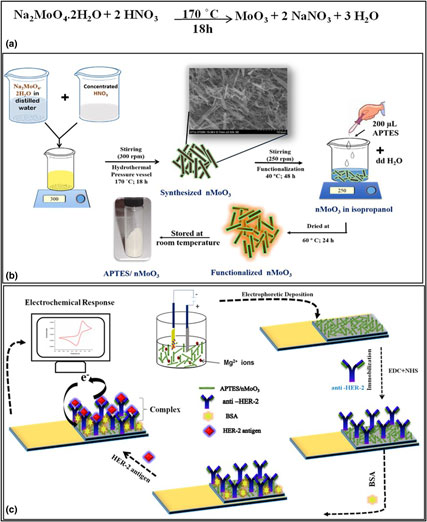Crossref Citations
This article has been cited by the following publications. This list is generated based on data provided by
Crossref.
Odularu, Ayodele T.
Ajibade, Peter A.
and
Mbese, Johannes Z.
2019.
Impact of Molybdenum Compounds as Anticancer Agents.
Bioinorganic Chemistry and Applications,
Vol. 2019,
Issue. ,
p.
1.
Sandil, Deepika
Sharma, Suresh C.
and
Puri, Nitin K.
2019.
Protein-functionalized WO3 nanorods–based impedimetric platform for sensitive and label-free detection of a cardiac biomarker.
Journal of Materials Research,
Vol. 34,
Issue. 08,
p.
1331.
Augustine, Shine
Kumar, Pragati
and
Malhotra, Bansi D.
2019.
Amine-Functionalized MoO3@RGO Nanohybrid-Based Biosensor for Breast Cancer Detection.
ACS Applied Bio Materials,
Vol. 2,
Issue. 12,
p.
5366.
Jalil, Owais
Pandey, Chandra Mouli
and
Kumar, Devendra
2020.
Electrochemical biosensor for the epithelial cancer biomarker EpCAM based on reduced graphene oxide modified with nanostructured titanium dioxide.
Microchimica Acta,
Vol. 187,
Issue. 5,
Ferreira, Daísy C.
Batistuti, Marina R.
Bachour, Bassam
and
Mulato, Marcelo
2021.
Aptasensor based on screen-printed electrode for breast cancer detection in undiluted human serum.
Bioelectrochemistry,
Vol. 137,
Issue. ,
p.
107586.
Zhumasheva, Nazerke
Kudreeva, Leyla
and
Kosybayeva, Diana
2021.
Molybdenum oxide based sensors.
Chemical Bulletin of Kazakh National University,
p.
28.
Vernet-Crua, Ada
Medina-Cruz, David
Mostafavi, Ebrahim
Benko, Aleksandra
Cholula-Diaz, Jorge Luis
Saravanan, Muthupandian
Vahidi, Hossein
Barabadi, Hamed
and
Webster, Thomas J.
2021.
Handbook on Nanobiomaterials for Therapeutics and Diagnostic Applications.
p.
511.
Tiwari, Abhishekh
Chaskar, Jyotsna
Ali, Ahmad
Arivarasan, Vishnu Kirthi
and
Chaskar, Atul Changdev
2022.
Role of Sensor Technology in Detection of the Breast Cancer.
BioNanoScience,
Vol. 12,
Issue. 2,
p.
639.
Zakaria, R.
Mahbub, M.
and
Lim, C.S.
2023.
Studies of surface plasmon resonance effect on different metallic layers of silver (Ag) and copper (Cu) with molybdenum trioxide (MoO3) for formaldehyde sensor.
Results in Optics,
Vol. 11,
Issue. ,
p.
100374.
Muthumanikkam, M.
Vibisha, Alagu
Lordwin Prabhakar, Michael Cecil
Suresh, Ponnan
Rajesh, Karupiya Balasundaram
Jaroszewicz, Zbigniew
and
Jha, Rajan
2023.
Numerical Investigation on High-Performance Cu-Based Surface Plasmon Resonance Sensor for Biosensing Application.
Sensors,
Vol. 23,
Issue. 17,
p.
7495.
Choudhari, Upasana
Gadekar, Pundlik
Ramgir, Niranjan
Jagtap, Shweta
Debnath, A. K.
and
Muthe, K. P.
2023.
Morphology-controlled synthesis of MoO3 nanostructures and its effect on heavy metal ion detection.
Journal of Materials Science: Materials in Electronics,
Vol. 34,
Issue. 25,
Anjali, Ch. Chaitanya
Vasimalla, Yesudasu
Srither, S. R.
Ramachandran, Balaji
Santhosh, Chella
Babu, Kodivendla
and
Kumar, Santosh
2025.
A Novel Approach for Enhanced Detection of Fat Concentration in Milk Using a Label-Free Nano Biosensor Employing Barium and Cadmium Gallium Sulfide.
Plasmonics,
Vol. 20,
Issue. 10,
p.
9309.
Sarsenbayeva, Aliya
Sadak, Selenay
Kucuk, Ipek
Kudreyeva, Leila
Bakytzhanovna, Abu Moldir
and
Uslu, Bengi
2025.
Molybdenum-Based Electrochemical Sensors for Breast Cancer Biomarker Detection: Advances and Challenges.
Critical Reviews in Analytical Chemistry,
p.
1.
Bhatti, Emmy
and
Kaur, Prabhpreet
2025.
Advances in sensor technologies for breast cancer detection: a comprehensive review of imaging and non-imaging approaches.
Discover Artificial Intelligence,
Vol. 5,
Issue. 1,
Naorem, Bilasini Devi
Singh, Lipi
Chirag, Purohit
Rayhan, Sreejan
Tejaswita
Singh, Jatinder Pal
Sharma, Babita
Chowdhuri, Arijit
Tomar, Monika
Verma, Mallika
and
Batra, Neha
2025.
Sustainable Uric Acid Detection Using Green-Synthesized MoO3 Thin Films.
Journal of Electronic Materials,
Vol. 54,
Issue. 11,
p.
9581.
Mathur, Parikshana
Dhanekar, Saakshi
and
Malhotra, B. D.
2025.
A review on breast cancer diagnostic techniques.
Sensors & Diagnostics,
Vol. 4,
Issue. 7,
p.
555.



